The Final Update: Flash Video Performance on Ion
by Anand Lal Shimpi on May 26, 2009 12:00 AM EST- Posted in
- Anand
It must be because this thing is so darn tiny that I don’t mind testing it all the time, but today’s short update marks the third follow up to our original Zotac Ion review.
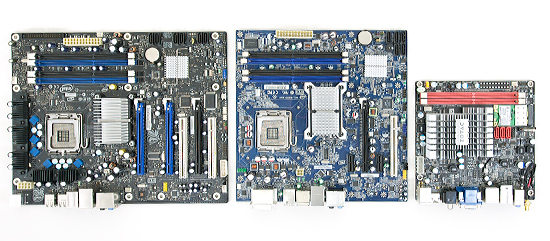
The original article crowned the Zotac Ion as the best Atom based mini-ITX board I’d ever encountered. It wasn’t a hard feat to accomplish, after all, there are only two other Atom based mini-ITX boards on the market and neither one offers a real GPU.
The first follow up addressed questions that readers of the first article had. Looking into things like the overclocking potential of the platform and additional detail on power consumption.
The second follow up addressed the Zotac’s wake-on-USB support, or lack thereof. Today I’m publishing what I hope to be my last update on this hardware until I get a new revision, but as always if there’s something you’d like to know don’t hesitate to ask.
Wake-on-USB Support: The Explanation
Zotac has been very proactive with getting me updates on its motherboard, I have their excellent North American PR rep to thank for that :)
As I mentioned in the last update, the Zotac Ion board won’t wake up from a S3 sleep state after activity on a USB device (e.g. moving your mouse, hitting a button on a media center remote, etc...). Zotac listed the problem as being a hardware issue that won’t get fixed until the next revision of the motherboard; early adopters are out of luck. I now have an explanation as to why.
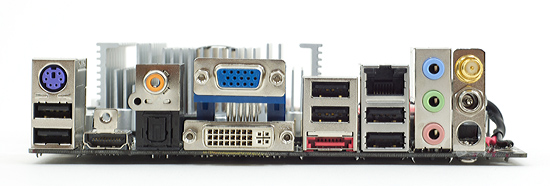
The USB ports on the current version of the motherboard (PCB version 00) are powered by the 5V rail from the motherboard. When the motherboard goes into a S3 sleep state, 5V power is shut off, so the USB ports are completely off.
In the next revision of the motherboard (PCB version 01) standby power will be connected to the USB ports, allowing the ports to still be alive when the board is in S3. The manual shows you where you can identify what PCB revision you have.
I’m guessing externally powered USB hubs are able to pull the system out of sleep since the USB device is still on, but a USB device connected directly to the motherboard will be completely powerless in S3. The explanation makes sense to me; if you were wondering, now you know.
Flash Video Playback on the Ion: Delving Deeper
I personally get most of my “TV” from Hulu so I completely understand the desire to know how well Intel’s Atom and the Ion platform in general perform when playing back Flash Video.
A few readers requested that I look deeper into the Ion’s FLV performance, especially when the Ion was overclocked. I had some spare time today so I did just that.
In my first follow up article I found that the Ion could play, without a problem, standard sized 360p and 480p Hulu videos. Attempting to increase the video window size to full screen yielded a highly unplayable video. I wanted to investigate further.
I used the latest version of Adobe’s Flash 10 player as well as Internet Explorer 8 under Windows Vista Ultimate 32-bit. With a desktop resolution of 1360 x 768 I tried five tests:
1) 360p, video window popped out and maximized to desktop resolution
2) 360p in Hulu’s full screen mode
3) 480p, video window popped out and maximized to desktop resolution
4) 480p in Hulu’s full screen mode
5) 720p playing a Hulu HD video
I ran the five tests in two configurations; first with the Atom 330 at its default 1.60GHz clock speed and second with the Atom overclocked to 1.92GHz (the highest stable frequency I could overclock the Atom to).
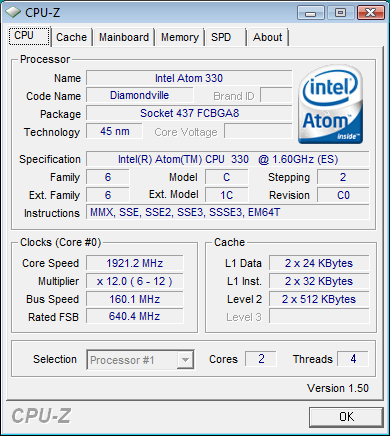
My impressions are in the table below:
| Scenario | Atom 330 @ 1.6GHz | Atom 330 @ 1.92GHz |
| 360p, maximized window | Some tearing, lower frame rate than default window, perhaps slightly smoother with hardware acceleration turned off? | Totally watchable, definitely lower frame rate but watchable |
| 360p, full screen | Totally unacceptable, not really higher CPU utilization than with a maximized window, but too choppy - distracting | Passable, not perfect but it can work if you can ignore some of the choppiness |
| 480p, maximized window | Slightly lower frame rate than the 360p test, but better picture quality so this may be a better option for some. Still annoying to watch due to lower frame rate. | Improved, I think passible. |
| 480p, full screen | Lots of tearing, somewhat more bearable than 360p full screen thanks to improved picture quality. I still prefer maximized window for higher frame rate. | Still choppy. |
| 720p HD | Completely unwatchable, CPU utilization > 90% | Still choppy but a bit better, painful but technically watchable |
While hardware acceleration was enabled in the Adobe Flash Player 10 settings, I can’t say that I noticed a performance difference with it enabled or disabled. I’m not really sure what it’s doing but it definitely didn’t help keep my framerate smooth when upscaling video.

CPU utilization was around 64% when watching a 360p stream in a maximized window
The only situation I would consider 360p full screen Hulu to be passable is when the system was overclocked to 1.92GHz. You’re far better off maximizing your browser window and dealing with the application border than running in Hulu’s seamless full screen mode.
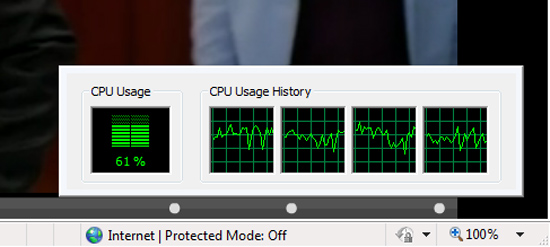
Overclocking the Atom dropped it to 61%, a small difference but noticeable
I will note that Hulu has difficulty playing in full screen on much faster systems as well, so I’m not sure we can really blame the Atom or Ion for its performance limitations here. It appears that video scaling under Flash is just not very efficient.
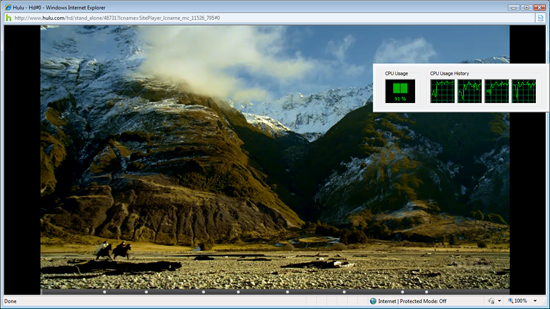
Hulu HD was basically unwatchable thanks to a > 90% CPU utilization
The HD stream is unplayable at stock frequencies but not because of scaling issues, since there's actually much less scaling being done from 720p to 1360 x 768. The HD stream falls victim to the Atom's limited CPU power, which overclocking helps overcome. I do still think that HD Hulu playback is too much for even an Atom 330 unfortunately.
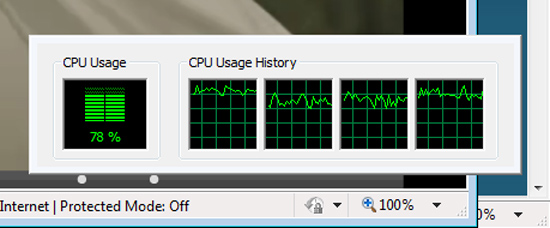
Overclocked, even HD hulu saw a benefit as CPU utilization dropped to below 80%
Overall the overclocking helped, but don’t expect any miracles. Be happy with smaller Hulu window sizes or be doomed to feel unfulfilled it seems. If NVIDIA wants a good case for CUDA, give us smooth FLV playback at any resolution and I'll be happy :)
With that said and done, it’s back to CPUs and SSDs for me.










56 Comments
View All Comments
BikeDude - Wednesday, May 27, 2009 - link
CPU spikes from banner ads? I've seen full blown 100% CPU usage for as long as the web page was open.I used to work on an application that displayed stock exchange information for users. Part of the application was a news feed with links to web pages. I.e. the app integrated IE using ActiveX.
That application required a certain amount of CPU. Without CPU power, it would sometimes lag behind and display old quotes.
So whenever users inadvertently hit a webpage with a maverick banner ad... Bye-bye sanity. And of course, our process was the one pegged with 100% CPU usage (since IE was at the time hosted inside that process space). At one point we told users to open those news outside our application, which helped a bit, because then they could identify that someone else was the culprit.
Such banner ads is a form of DoS-attack. The victims will often be clueless about what is going on, and are unable to use their computers normally.
AndreasM - Wednesday, May 27, 2009 - link
I wonder if it would be capable of running HTML5 based video smoothly, e.g. http://www.youtube.com/html5">http://www.youtube.com/html5BernardP - Wednesday, May 27, 2009 - link
The thing is, Flash Video is resource hungry. On my Athlon dual-core 5400+ NVidia 8200 IG, I average 30% to 40% CPU utilisation when streaming YouTube HQ (not HD) video at full-screen (in my case, a custom rez. of 1384x864). No wonder the Atom is struggling.gwolfman - Wednesday, May 27, 2009 - link
..."If NVIDIA wants a good case for CUDA, give us smooth FLV playback at any resolution and I'll be happy :) ..."Do it Anand, you can make it happen!
alpensiedler - Wednesday, May 27, 2009 - link
[quote]so I’m not sure we can really blame the Atom or Ion for its performance limitations here[/quote]let's blame adobe for a crappy standard. imo flash is very crappy. still no x64? runs poorly on decent hardward? bloatware with the windows install? seriously flash is garbage, i wish we'd adopt a better standard.
lwatcdr - Wednesday, May 27, 2009 - link
There is an X64 build of Flash. It just happens to be for Linux. Which makes me wonder if the X84 build running under Linux would do any better?I can play Hulu on my Linux box... Hey don't put that ION system away just yet. Time to fire up Ubuntu X64 and give it a shot.
robhancock - Thursday, May 28, 2009 - link
The x64 build of Flash seems to still be crap, last time I checked. It performs even worse than the 32-bit version since hardware acceleration (what little there is) isn't implemented.Flash is just a CPU pig in general. You can take the exact same Flash video that takes 80% of the CPU in Flash and play it in Totem or VLC and it will use a tiny fraction of that amount of CPU time. It's really unfortunate that so much video on the web is using such a crappy player..
sprockkets - Friday, May 29, 2009 - link
Better than Real, Windows only Windows Media, or the plague of Quicktime.icrf - Wednesday, May 27, 2009 - link
Yeah, what he said. My goal is to boot XBMC off a USB flash stick, so some linux tests would be nice.B3an - Wednesday, May 27, 2009 - link
I know you wouldn't think that using a different browser would make a difference with Flash performance, as the browser is just a container, but it does.I've been a Flash developer for years and have noticed how different browsers have different performance and CPU usage with Flash. Normally upto 15% perfromance difference at most, and some browsers have tiny micro stutters in the frame rate every now and again (which is only really noticable with something running at a high frrame rate, like a Flash game).
So maybe update this with a couple of other browsers? Although i very much doubt it will make a dramatic difference.